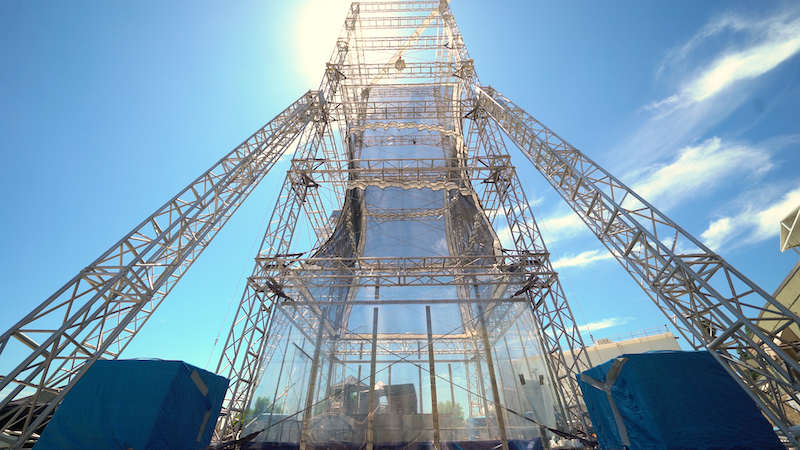As we know, landing on Mars is hard. Many landing attempts over decades failed, with the lander sadly smashing into Mars’ desert surface. Safe touchdowns are more the norm now (although still always nail-biters). But what if you wanted to crash into Mars … on purpose? NASA said last week (October 20, 2022) that it’s testing a new type of lander – called SHIELD – that would intentionally crash land.
The thinking is that the easiest way to land on Mars might be to just crash, but with a lander designed to survive a hard impact.
Crash landing on Mars
Why is it so hard to land on Mars? The reason is Mars’ thin atmosphere. Landers and rovers have had to use huge parachutes, airbags and jetpack-style sky cranes in order to land as gently as possible. But NASA’s newest concept, the Simplified High Impact Energy Landing Device (SHIELD), would forgo those technologies.
Instead, SHIELD would use an accordion-like collapsible attenuator base on the lander. It looks like an inverted pyramid of metal rings.
The base would act like the crumple zone of a car, absorbing the impact.
Reducing costs and new landing sites
One key benefit of using SHIELD would be a reduction in cost. Mars missions are very expensive to launch, land and then maintain on the surface. SHIELD would significantly simplify the landing process, reducing the cost. Also, typically, out of necessity, Mars surface missions have landed in spots with relatively few craters or large rocks. Crash-landing would let Mars spacecraft touch down in riskier areas. Lou Giersch of NASA’s Jet Propulsion Laboratory (JPL) said:
We think we could go to more treacherous areas, where we wouldn’t want to risk trying to place a billion-dollar rover with our current landing systems. Maybe we could even land several of these at different difficult-to-access locations to build a network.

Crash landing on Mars … and on Earth
NASA makes an interesting comparison to support its SHIELD concept. When the first Mars samples are eventually returned to Earth, they will be in a capsule that will crash land on Earth’s surface, by design, likely in a desert region. If we can do that, why not to explore crash landings on Mars as well? As Velibor Cormarkovik, part of the SHIELD team, noted:
If you want to land something hard on Earth, why can’t you do it the other way around for Mars? And if we can do a hard landing on Mars, we know SHIELD could work on planets or moons with denser atmospheres.
The same technique has been used for samples brought back to Earth from asteroids and comets.
Protecting the lander
Of course, during the crash landing, NASA wants the lander itself to survive the impact. So, in 2022, the team tested the concept, using a drop tower at JPL in Pasadena, California. The test included similar sample tubes to the ones that the Perseverance rover is using to collect its samples for later return to Earth. Could the sample tubes survive a crash? The drop tower, nearly 90 feet (27 meters) tall, hurls objects to the Earth’s surface at speeds like those of a Mars crash landing. The technique is similar to how cars are tested on Earth using crash test dummies on sleds. Cormarkovik said:
The tests we’ve done for SHIELD are kind of like a vertical version of the sled tests. But instead of a wall, the sudden stop is due to an impact into the ground.

It worked!
The test only took two seconds. And … success! The collapsible attenuator included a smart phone, a radio and an accelerometer. After SHIELD rose to the top of the tower, the countdown began. Nathan Barba, another SHIELD project member, said:
Hearing the countdown gave me goose bumps. The whole team was excited to see if the objects inside the prototype would survive the impact.
SHIELD hit the ground at about 110 miles (177 km) per hour, the same speed that a lander is typically moving at as it nears the Martian surface. It impacted with a force of about 1 million newtons, equivalent to about 112 tons.
In this test, SHIELD crashed into a steel plate that was 2 inches (5 cm) thick. This mimicked a harder landing on Mars. In previous tests, SHIELD had crashed into dirt. Interestingly, SHIELD bounced about 3.5 feet (about a meter) after impact. The SHIELD team says this is likely due to the steel plate, since there was no bounce in the previous tests.
As for the phone and other devices onboard, they all survived the impact. That’s good news for future tests and the concept overall. The SHIELD team was quite happy with the results. Giersch said:
The only hardware that was damaged were some plastic components we weren’t worried about. Overall, this test was a success!

Bottom line: NASA has successfully tested a new Mars lander concept called SHIELD, which is specifically designed for intentionally crash landing on Mars.











